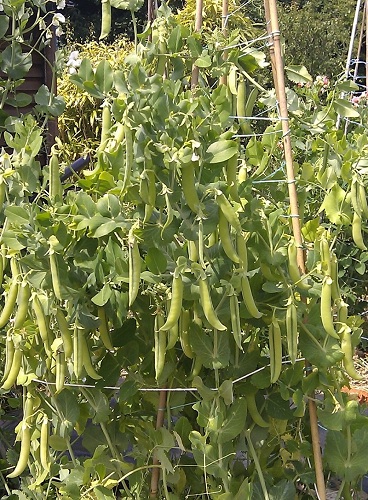PEAS
Heritage Peas pods growing
Peas are almost entirely self pollinating, and only very occasionally cross with other plants.
The best way to save seed is to set aside a section of a row that is just for seed production. General advice is to try and make sure the growing season is as long as possible to allow the pods to mature and dry, so early plantings are best. The added plus of sowing early is that Pea Moth can (may) be avoided)
As peas are inbreeders (that is, they self-pollinate), you can save seed from just a few plants — it is better, though, if you grow as many plants as possible (HSL recommend around ten plants per variety).

Peas ripening in the pods
How to grow and save seed from Peas
- To avoid mixing up of the seeds, separate different varieties of pea with another crop. You should check the plants from time to time as the peas grow, and take out any plants that are weak or not true to type.
- Some plants may produce noticeably different foliage or pods from the majority of the plants; you should not save seed from these atypical ones, and the plants should be removed.
- Let the peas mature until the pods are brown and the seeds start to rattle. If the weather is bad or there is a risk of frost, pull up the whole plants and bring inside (for example hung upside down from the shed roof) to ripen and dry further.
- Once the pods are really dry, shell the peas out. The shelled peas need to be dried a bit more to make sure they wont rot when you store them so dry them a bit more in a warm (but not hot) place, label and date them and store in jars or envelopes.
- Remove any peas that are damaged or discoloured.
- Store in a cool, dry place. Pea seeds should last in storage for at least three
years.

Heritage peas drying at home
Pea Pests and what to look out for
HSL advice on the Pea Moth – “You may notice small holes in some of the seed with a powdery deposit round them. This is a sign of pea moth, which lay their eggs on pea flowers. The caterpillars then eat their way out of the pods, often eating a few of the pea seeds in the process. If you notice signs of pea moth in harvested peas, you should pod them immediately or they will continue being eaten.” One way to ensure Pea Moths don’t continue munching on your dried (saved) peas is to freeze them for approx 2 days, this will make sure the pea moths are killed.

Peas drying at home

One comment